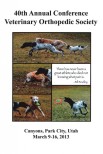Objective: To describe the equipment and accuracy of a table-bound reduction system and three-dimensional (3D) printed drill guide for fluoroscopically guided, minimally invasive sacroiliac luxation (SIL) reduction and stabilization by means of a single iliosacral lag screw in cats.
Study design: Retrospective case series.
Animals: A total of 17 cats (20 screws).
Methods: Medical records of a single institution were retrospectively reviewed for cats that underwent SIL reduction and stabilization as described in the above objective. Postoperative images were assessed for screw positioning, percentage of sacroiliac reduction, sacral width purchase, and craniocaudal and dorsoventral screw angulation.
Results: Sacral width purchase was 82.52% ± 10.67. Percentage of sacroiliac (SI) joint reduction was 94.25% ± 8.14. Craniocaudal screw angle was -1.22° ± 3.96. Dorsoventral screw angles was 0.7° ± 3.90. All screws were classed as being positioned within the sacral body (in).
Conclusion: Stabilization of SIL in cats by mean of a single iliosacral screw placed minimally invasively using intraoperative fluoroscopy and a table bound reduction system and 3D printed drill guide system, led to screws that were repeatably placed within the sacral body based on either computed tomography (CT) scan assessment or subjective radiographic assessment.
Clinical significance: The described technique and equipment allow placement of iliosacral screws in cats with repeatable accuracy.









